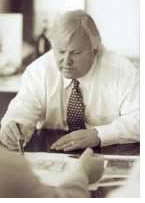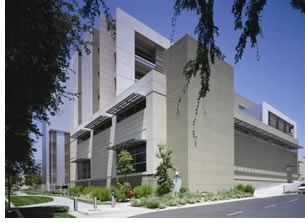

09/2005
 Adrian
Smith, FAIA, consulting design partner in the Chicago office of Skidmore,
Owings & Merrill, will be presented City of Hope’s Spirit of
Life® Award at the construction and real estate industry’s
annual dinner on Chicago’s Navy Pier November 3. Smith, who is
currently leading a year-long campaign expected to raise more than $300,000
for City of Hope Cancer Center, will receive the honor for his efforts
in the community and his leadership in the construction and real estate
industry. Nearly 1,000 industry executives will attend the reception
and dinner. Here, Smith tells AIArchitect about his involvement with
the City of Hope and shares some thoughts about how health-care architecture
can help advance medical research and patient care.
Adrian
Smith, FAIA, consulting design partner in the Chicago office of Skidmore,
Owings & Merrill, will be presented City of Hope’s Spirit of
Life® Award at the construction and real estate industry’s
annual dinner on Chicago’s Navy Pier November 3. Smith, who is
currently leading a year-long campaign expected to raise more than $300,000
for City of Hope Cancer Center, will receive the honor for his efforts
in the community and his leadership in the construction and real estate
industry. Nearly 1,000 industry executives will attend the reception
and dinner. Here, Smith tells AIArchitect about his involvement with
the City of Hope and shares some thoughts about how health-care architecture
can help advance medical research and patient care.
Q. Why is the City of Hope an organization you support?
A. The City of Hope is a vital organization in the search for a cure
to our society’s most pressing complex health challenges—such
as cancer, AIDS, and diabetes—through research, treatment, and
education programs. They have a proven record of accomplishment in
this regard and are totally focused on finding cures using groundbreaking
research, such as immunotherapy and tumor immunology. They are the
only institution with four FDA-authorized clinical trials using genetically
reprogrammed T-cells and the largest freestanding biologic production
facility in the nation. In addition, a very high percentage of donations
go directly to research.
 Q. What is it like partnering with your colleagues/competitors in an
endeavor such as this fund raising effort for the City of Hope?
Q. What is it like partnering with your colleagues/competitors in an
endeavor such as this fund raising effort for the City of Hope?
A. It is very gratifying to be involved with your peers in the real estate,
construction, and design industry in support of the goals and objectives
of the City of Hope. I believe that we, as professionals, are in a daily
partnership in the exercising of our skills to advance the quality of
the built environment and that the accomplishment of our competitors
is a contribution to the whole of society upon which we can all build.
Our collaboration with them regarding the City of Hope takes this premise
to a different level—a more broad-reaching level—and what
we have in common is a desire to enhance the quality of life for all.
Q. What are the newest advances in health/medical and science/research
architecture that will help advance medical research and patient care?
A. I am not an expert in this field of architecture, but I know that
there are significant advances in the use of materials and construction
techniques and mechanical ventilation systems that make biomedical research
and application a feasible option for the discovery of new cures. Many—in
fact, most—of the medical facilities around the world are not designed
for the extremely demanding clean environments necessary to carry on
such research and treatment.
I recently toured one new facility that provides state-of-the-art accommodations for advanced medical research and patient care: the Helford Clinical Research Hospital on the City of Hope campus. It is a spectacular facility that will accelerate the City of Hope’s paradigm for translational medicine by turning scientific discoveries into improved treatments. It will help usher in a new era of advanced research, education, and patient care.
Q. How can scientific research efforts be fostered through design?
A. Designing complex clinical and research facilities is as much diagnostic
as it is programmatic. It’s diagnostic in the context of defining
the nature of the current activity with known research techniques—as
well as that which is likely to take place in the next 5, 10, and 20
years as research and care advance to a status we can only dream of
at this point. Good design can help the medical community to plan ahead
in the design and construction of their facilities, even to the demolition
of functionally obsolete facilities. It can also provide innovative
and creative components to allow for the dreams and inspirations of
the scientific community to develop.
Q. Can you point to a few projects that exemplify that type of architecture?
A. I think there are very few projects that explore the opportunities
and possibilities for future needs and discoveries that can change
the way medicine is practiced. There must be biomedical research and
health-care architecture specialists who focus not only on the technological
advances of today but also on the medical profession of tomorrow so
that we can work together with our medical and research professionals
to anticipate constantly the future space needs. Most medical facilities
built today are very inflexible and can easily become obsolete when
new discoveries demand a different environment.
Q. What are other philanthropic endeavors in which you are involved?
A. I am involved as a board member to the School of the Art Institute
of Chicago and on the advisory board for their new Department of Architecture
and Design. I am a governor for the Urban Land Institute Foundation
and a representative for the RIBA British Architectural Library Trust.
I am also very active in the Chicago Central Area Committee, a group
of civic leaders that identifies and seeks solutions for the Chicago
Central Business District. My wife Nancy and I are also contributors
to Open Lands organizations for the preservation of open spaces within
our communities.
Copyright 2005 The American Institute of Architects.
All rights reserved. Home Page ![]()
![]()
